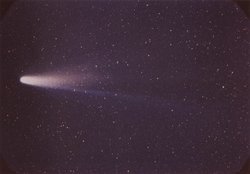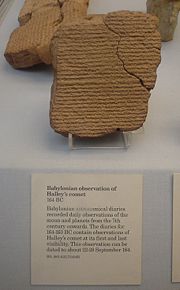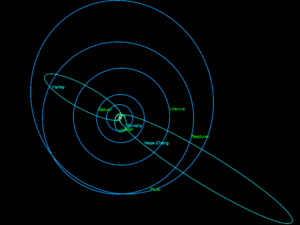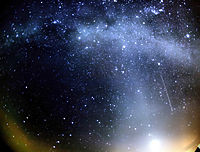Halley's Comet
2008/9 Schools Wikipedia Selection. Related subjects: Space (Astronomy)
 |
|
| Discovery | |
|---|---|
| Discovered by: | prehistoric; Named after Edmond Halley |
| Discovery date: | 1758 (first predicted perihelion) |
| Alternate designations: | Halley's Comet, 1P (see Designation below) |
| Orbital characteristics A | |
| Epoch: | 2449400.5 ( February 17, 1994) |
| Aphelion distance: | 35.1 AU ( December 9, 2023) |
| Perihelion distance: | 0.586 AU |
| Semi-major axis: | 17.8 AU |
| Eccentricity: | 0.967 |
| Orbital period: | 75.3 a |
| Inclination: | 162.3° |
| Last perihelion: | February 9, 1986 |
| Next perihelion: | July 28, 2061 |
Halley's Comet, officially designated 1P/Halley and also referred to as Comet Halley after Edmond Halley, is a comet that can be seen every 75–76 years. It is the most famous of all periodic comets. Although in every century many long-period comets appear brighter and more spectacular, Halley is the only short-period comet that is clearly visible to the naked eye, and thus, the only naked-eye comet certain to return within a human lifetime. Halley's Comet last appeared in the inner Solar System in 1986, and will next appear in mid 2061.
Pronunciation
Halley is generally pronounced /ˈhælɪ/, rhyming with valley, or (especially in the US) /ˈheɪlɪ/ "Hailey", but Edmond Halley himself probably pronounced his name /ˈhɔːlɪ/ "Hawley", with the "hall-" rhyming with "call" or "small".
Edmond Halley's study
Halley's Comet was the first comet to be recognized as periodic. Perceiving that the observed characteristics of the comet of 1682 were nearly the same as those of two comets which had appeared in 1531 (observed by Petrus Apianus) and 1607 (observed by Johannes Kepler in Prague), Halley concluded that all three comets were in fact the same object returning every 76 years (a period that has since been amended to every 75–76 years). After a rough estimate of the perturbations the comet would sustain from the attraction of the planets, he predicted its return for 1758. Halley's prediction of the comet's return proved to be correct, although it was not seen until 25 December 1758 by Johann Georg Palitzsch, a German farmer and amateur astronomer, and did not pass through its perihelion until March 13, 1759; the attraction of Jupiter and Saturn having caused a retardation of 618 days, as was computed by a team of three French mathematicians, Alexis Clairault, Joseph Lalande, and Nicole-Reine Lepaute, previous to its return. Halley did not live to see the comet's return, having died in 1742.
Notable appearances
Halley's calculations enabled the comet's earlier appearances to be found in the historical record.
Early appearances

- 240 BC and earlier: Historical records show that Chinese astronomers observed the comet's appearance in 240 BC and possibly as early as 467 BC. Habitual observations and calculations of appearances after 240 BC are recorded by Chinese, Babylonian, Persian, and other Mesopotamian astronomers.
- 87 BC: According to V.G. Gurzadyan and R. Vardanyan, the "Symbol on Tigranes the Great's crown that features a star with a curved tail may represent the passage of Halley's comet in 87 BC. Tigranes could have seen Halley's comet when it passed closest to the Sun on Aug. 6 in 87 BC according to the researchers, who said the comet would have been a 'most recordable event' — heralding the New Era of the brilliant King of Kings.
- 12 BC: Some theologians have suggested that the comet's appearance in 12 BC might explain the Biblical story of the Star of Bethlehem.
- AD 66 : In the Talmud, it is mentioned that "There is a star which appears once in seventy years that makes the captains of the ships err". Since this quote is attributed to the Rabbi Yehoshua ben Hananiah, if it is indeed a reference to Halley's Comet, it probably refers to the AD 66 perihelion, which was the only one to occur during his lifetime.
- 837: In this year, it is calculated that Comet Halley may have passed as close as 0.03 AU (3.2 million miles; 5.1 million kilometres) from Earth, by far its closest approach. Its tail may have stretched 90 degrees across the sky.
- 1066: The comet was seen in England and thought to be an omen: later that year Harold II of England died at the Battle of Hastings. Thus it was a bad omen for Harold, but a good omen for William the Conqueror. Shown on the Bayeux Tapestry, and the accounts which have been preserved represent it as having then appeared to be four times the size of Venus, and to have shone with a light equal to a quarter of that of the Moon. This appearance of the comet is also noted in the Anglo-Saxon Chronicle. Having first seen it as a young boy in 989, Eilmer of Malmesbury declared prophetically in 1066: "You've come, have you?…You've come, you source of tears to many mothers, you evil. I hate you! It is long since I saw you; but as I see you now you are much more terrible, for I see you brandishing the downfall of my country. I hate you!" . Chaco Native Americans in New Mexico recorded this 1066 comet in their petroglyphs.
- 1301: The artist Giotto di Bondone could have observed the comet and his depiction of the Star of Bethlehem in the Nativity in the Arena Chapel cycle completed in 1305 is a candidate for an early depiction.
- 1456: The comet passed very close to the Earth; its tail extended over 60° of the heavens and took the form of a sabre. According to one story, first appearing in a posthumous biography in 1475 and later embellished and popularized by Pierre-Simon Laplace, Pope Callixtus III excommunicated the 1456 apparition of the comet, believing it to be an ill omen for the Christian defenders of Belgrade, who were at that time being besieged by the armies of the Ottoman Empire. However, no known primary source supports the authenticity of this account.
Recent history
The most recent appearances have been in 1835, 1910, and 1986. Halley will next return in 2061.
1835
American satirist and writer Mark Twain was born on November 30, 1835, exactly two weeks after the comet's perihelion. In his biography, he said, "I came in with Halley's comet in 1835. It's coming again next year (1910), and I expect to go out with it. The Almighty has said no doubt, 'Now here are these two unaccountable freaks; they came in together, they must go out together.' " Twain died on April 21, 1910, the day following the comet's subsequent perihelion. The 1985 fantasy film The Adventures of Mark Twain is inspired by this.
1910
The April 1910 approach, which came into view around April 20, was notable for several reasons: it was the first approach of which photographs exist, and the comet made a relatively close approach, making it a spectacular sight. Indeed, on May 18, the media, despite the pleas of astronomers, wove sensational tales of mass cyanide poisoning engulfing the planet. In reality, the gas is so diffuse that the world suffered no ill effects from the passage through the tail.
Many people who claim to remember seeing the 1910 apparition are probably in fact remembering a different comet, the Great Daylight Comet of 1910, which surpassed Halley in brilliance and was actually visible in broad daylight for a short time about four months before Halley made its appearance.
1986
The 1986 approach was the least favourable for Earth observers of all recorded passages of the comet throughout history: the comet did not achieve the spectacular brightness of some previous approaches, and with increased light pollution from urbanization, many people never saw the comet at all. Further, the comet appeared brightest when it was almost invisible from the northern hemisphere in March and April, prompting many amateur astronomers to travel to the southern hemisphere for a glimpse of the interloper. However, the development of space travel allowed scientists the opportunity to study the comet at close quarters, and several probes were launched to do so. The Soviet Vega 1 started returning images of Halley on 1986 March 4, and the first ever of its nucleus, and made its flyby on March 6, followed by Vega 2 making its flyby on March 9. On March 14, the Giotto space probe, launched by the European Space Agency, made a closest pass of the comet's nucleus. There were also two Japanese probes, Suisei and Sakigake. The probes were unofficially known as the Halley Armada.
The first person to visually observe comet Halley on its 1986 return was amateur astronomer Stephen James O'Meara on January 24, 1985. O'Meara used a home-built 24" telescope on top of Mauna Kea to detect the magnitude 19.6 comet. As for the naked eye observing, it was Stephen Edberg (then serving as the Coordinator for Amateur Observations at NASA's Jet Propulsion Laboratory) and Charles Morris who were the first to observe Comet Halley with the naked eye in its 1986 apparition.
During the Halley's Comet viewing, Yuma, Arizona, was the best place to see the comet without machine. During the week of April 4, the city of Yuma gave the title "Halley's Comet Baby" to the first baby born during that week.
Based on data, retrieved by Astron, the largest ultraviolet space telescope of the time, during its Halley's Comet observations in December 1985, a group of Soviet scientists developed a model of the comet's coma. The comet was also observed from space by the International Cometary Explorer. Originally International Sun-Earth Explorer 3 the probe was renamed and freed from its L1 Lagrangian point location in Earth's orbit to intercept comets 21P/Giacobini-Zinner and Halley.
Two Space Shuttle missions — the ill-fated STS-51-L (the Challenger disaster) and STS-61-E — were scheduled to observe Comet Halley from low Earth orbit. 61-E would have been flown by Challenger in March 1986, carrying the ASTRO-1 platform to study the comet. The mission was canceled, and ASTRO-1 would not fly until late 1990 on STS-35.
Origin
Comets are believed to have two separate points of origin in the Solar System: the Kuiper belt, a flat disc of icy debris between 38 AU (Pluto's orbit) and 50 AU from the Sun, and the Oort cloud, a sphere of cometary bodies which has its inner edge at 50,000 AU. Short period comets (those with orbits lasting 200 years or less) are generally accepted to have emerged from the Kuiper belt, while long period comets, such as Hale-Bopp, whose orbits last for thousands of years, are believed to originate in the Oort cloud. Halley is unusual in that while it is a short period comet, its ultimate origin lies in the Oort cloud, not the Kuiper belt. Its orbit is such that it is believed to have been originally a long period comet but to have been captured by the gravity of the giant planets and sent into the inner Solar System. Halley is grouped with other comets that share this orbit into the Halley family comets.
Orbit

Halley's orbit is highly elliptical, and focused on the Sun. Its perihelion, its closest distance to the Sun, is just 0.6 AU (between the orbits of Mercury and Venus), while its aphelion, or farthest distance from the Sun, is 35 AU, or roughly the distance of Pluto. Unusually for an object in the Solar System, Halley's orbit is retrograde; it orbits the Sun in the opposite direction to the planets, or clockwise from above the Sun's north pole. Its orbit is highly inclined (18°) to the ecliptic, with much of it lying below the orbits of the planets (assuming Earth's north pole is "up").
Due to Halley's highly eccentric orbit, it has one of the highest velocities relative to the Earth in the solar system. The 1910 passage was at a relative velocity of 70.56 km/s (157,800 MPH).
Structure and composition
The Giotto mission gave planetary scientists their first view of Halley's surface and structure. Although its coma may extend about 100 million kilometres into space, Halley's nucleus is relatively small (barely 15 kilometres long, 8 kilometres wide and 8 kilometres thick) and roughly peanut-shaped. Its mass is extremely low; roughly 2.2×1014 kg. Its average density is about 0.6 g/cm³, indicating that it is very loosely constructed. Its albedo is about 4 percent, meaning that only 4 percent of the sunlight hitting it is reflected; about what one would expect for coal. Thus, despite appearing brilliant white to observers on Earth, Halley's comet is in fact pitch black. Its nucleus has an albedo only of 0.03, darker than coal. As it approaches the inner Solar System, the Sun warms it, causing its surface to sublimate (change directly from a solid to a gas), and jets of volatile material to burst from its black surface. The nucleus rotates every 52 hours, and its day side is far more active than its night side. The gases ejected from the nucleus are 80 percent water vapour, 17 percent carbon monoxide and 3–4 percent carbon dioxide with traces of hydrocarbons.
The nucleus is covered with a layer of dust, which retains heat. Each large dust grain is thought to consist of many tiny particles with spaces in between. Some of these spaces are filled with ice, and others are empty. When Halley's comet is closest to the Sun, temperatures can rise to about 77 °C. Near the Sun, several tons of gas and dust are emitted each second in the jets. Halley has several shallow craters which are about 1 km in diameter.
Meteor showers
Because its orbit comes close to Earth's orbit in two places, Comet Halley is the parent body of two meteor showers: the Eta Aquarids in early May, and the Orionids in late October. The Eta Aquarids show orbital similarites approaching Earth as they do of Mars and so a meteor shower at Mars is anticipated there as well but this time appearing to come from Lambda Gemini.
Designation
This table sets out the astronomical designation for various apparitions of Halley's Comet. For example, "(1P/1982 U1, 1986 III, 1982i" indicates that for the perihelion in 1986, Halley's Comet was the first period comet known (designated 1P) and this apparition was the first seen in "half-month" U (the first half of November) in 1982 (giving 1P/1982 U1); it was the third comet past perihelion in 1986 (1986 III); and it was the ninth comet spotted in 1982 ( provisional designation 1982i). The perihelion dates of each apparition are shown. The perihelion dates farther from the present are approximate, mainly because of uncertainties in the modeling of non-gravitational effects.
|
|
Note that perihelion dates 1607 and later are in the Gregorian calendar, while perihelion dates of 1531 and earlier are in the Julian calendar.


